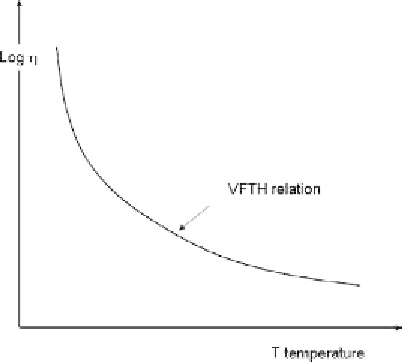Biomedical Engineering Reference
In-Depth Information
Figure 2.12
Thermaldependencyoftheviscosityofapolymericliquid.
2.2.2.5
ViscosityandShearRate—ViscoelasticBehavior
Besides its dependency on concentration and temperature, the viscosity of poly-
meric solutions decreases with the shear rate of the flow, because, in high shear
regions, the long polymer chains align with the flow; such a behavior is called
shear
thinning
. Many different laws have been proposed for the non-Newtonian viscosity,
depending on the carrier liquid and polymers.
Small Shear Rates
In the domain of small shear rates, the Ostwald [12] relation is a good approxima-
tion of the viscosity
η γ
-
�
1
n
(2.26)
=
and, using (2.15), the shear stress can be expressed as
�
n
τ γ
=
(2.27)
When
n
= 1, the viscosity does not depend on the shear stress and the liquid is
Newtonian. A value 0 <
n
<1 corresponds to a shear thinning liquid.
Medium Shear Rates
In the domain of medium shear rates, for shear thinning liquids, it is common to use
the Carreau-Yasuda relation [13]
-
1
m
α
α
.
(2.28)
η η
=
0
[(1 (
+
τγ
) ]
where
η
0
is the viscosity at zero shear rate given by (2.23)
η
0
=
η
s
(1 +
η
sp
), is the
shear rate,
τ
is the relaxation time (we will discuss the relaxation time in the next
section),
α
is a constant, and
m
depends on the concentration of the solution. Again,











